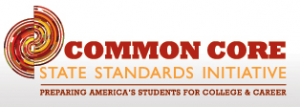This is a guest blog from Takeshi Terada. Takeshi’s interests are in educational policy and assessment. He is particularly interested in data-driven educational evaluation, policy-making & analysis, and decision-making systems in K-12 education that apply both qualitative and quantitative research methodologies, mostly using assessment test scores. Takeshi is a graduate of the University of Minnesota and can be reached at tera0026@umn.edu. Starting in October, Takeshi will be a Program Associate providing program and research support to the Partnership for the Assessment of Readiness for College and Careers (PARCC) at Achieve, an independent bi-partisan, non-profit organization, and a national leader in education reform, based in Washington, DC. This is Part 1 in his series on the Common Core State Standards Initiative.
The Common Core State Standards Initiative
 In June 2010, the National Governors Association and the Council of Chief State School Officers announced the Common Core State Standards (CCSS) for K-12 English Language Arts and mathematics (Center on Educational Policy [CEP], 2010). The CCSS is a state-led initiative that grew out of concerns that the different state standards currently used do not adequately prepare students with the knowledge and skills needed to succeed in college and the workplace (Tamayo, 2010; CEP, 2010). The new common standards are expected to provide assistance for how states and school districts organize and support the challenging work principals and teachers face to improve student outcomes (Tamayo, 2010).
In June 2010, the National Governors Association and the Council of Chief State School Officers announced the Common Core State Standards (CCSS) for K-12 English Language Arts and mathematics (Center on Educational Policy [CEP], 2010). The CCSS is a state-led initiative that grew out of concerns that the different state standards currently used do not adequately prepare students with the knowledge and skills needed to succeed in college and the workplace (Tamayo, 2010; CEP, 2010). The new common standards are expected to provide assistance for how states and school districts organize and support the challenging work principals and teachers face to improve student outcomes (Tamayo, 2010).
Nearly 10 years ago, The No Child Left Behind Act (NCLB) was enacted and requires all students to become proficient in reading and mathematics by 2014. This was expected to raise the standards for all students. However, students in many states are still outperformed by students in other countries (Daggett & Gendron, 2010). This is partly because NCLB allows each state to determine what students need to learn, how they should be tested, and what level of achievement determines proficiency (Daggett & Gendron, 2010). As a result, as I mentioned in my previous blog, many states have lowered their proficiency levels to make it relatively easier for their local students to reach the proficiency levels, which can have some negative effects on student performance. In addition, because there is no uniform standard across the nation, it is difficult to define nationally what every student across America is expected to know or can do (Daggett & Gendron, 2010). Therefore, the CCSS move is critical for making learning more rigorous across the nation (Daggett & Gendron, 2010).
Features and Goals
The CCSS is initiated and developed by states, rather than the federal government. Additionally, it is a voluntary initiative. Each state can decide whether or not to adopt the standards (CEP, 2010). The final goal of the CCSS is to ensure that students have enough knowledge and skills in mathematics and English Language Arts so that they can graduate from high school and get ready for college and careers (Achieve, 2010). Daggett and Gendron (2010) note the following key features of the CCSS:
- Aligned with college and work expectations;
- Clear, understandable, and consistent;
- Rigorous content and application of knowledge through higher-order skills;
- Built upon strengths and lessons of current state standards;
- Informed by other top-performing countries so that all students are prepared to succeed in the global economy and society.
Roles and Benefits
For the success of the CCSS, it is essential to create a coherent assessment system for meeting college- and career-ready expectations. Achieve (2010) notes that an assessment system developed around the CCSS should exhibit the following features:
- Effectively measure the depth and breadth of the CCSS;
- Inform and improve the quality and consistency of instruction;
- Indicate whether or not students are reaching milestones that signify readiness; and
- Hold educators and schools accountable for improving student performance and readying students for postsecondary education and careers.
Having common assessments will also offer various benefits, including:
- Allowing states to compare student performance on a common metric;
- Reducing the cost of assessment;
- Assisting innovations in research and technology to develop assessment systems collaboratively, not by individual sate; and
- Providing opportunities for cross-state collaboration in other critical areas such as development of curriculum materials, instructional tools, and teacher development.
Challenges
For a smooth transition state assessment system to the CCSS assessment system, it is critically important to:
- Refocus state assessments to measure the knowledge and skills targeted by the CCSS;
- Improve the quality and types of items to assess more cognitively-challenging tasks;
- Shift from a single state-wide assessment test to various types of assessments to monitor academic progress more precisely for better classroom instruction; and
- Establish college- and career-ready assessment system aligned to high school assessments to ensure that students are ready for college and careers (Achieve, 2010).
To work out these challenges, states are required to work together to develop a shared assessment system. When it is finally developed, what will this assessment system look like? How will it be received by the teachers and students? How will it be used in the classroom? I am excited to see and take part in the development of such a system.
References
Achieve (2010). On the road to implementation: Aligning assessments with the common core state standards. Retrieved July 22nd, 2011, from http://www.achieve.org/files/FINAL-CCSSImplementationGuide.pdf
Center of Educational Policy (2010). State’s progress and challenges in implementing common core state standards. Retrieved July 26, 2011, from http://www.cep-dc.org/cfcontent_file.cfm?Attachment=KoberRentner%5FReport%5FStateProgressCommonCoreStateStandards%5F010611%2Epdf
Daggett, W. R. & Gendron, S. (2010). Common Core State Standards Initiative Classroom Implications for 2014. International Center for Leadership in Education. Retrieved July 24th, 2011, from http://www.leadered.com/pdf/Common%20Core%20Standards%20Paper%20FINAL.pdf
Tamayo Jr., J. R. (2010). Assessment 2.0: “Next-Generation” Comprehensive Assessment Systems, The Aspen Institute Education & Society Program. Retrieved July 25th, 2011, from http://www.aspeninstitute.org/sites/default/files/content/docs/pubs/ed-ESPreport.pdf

